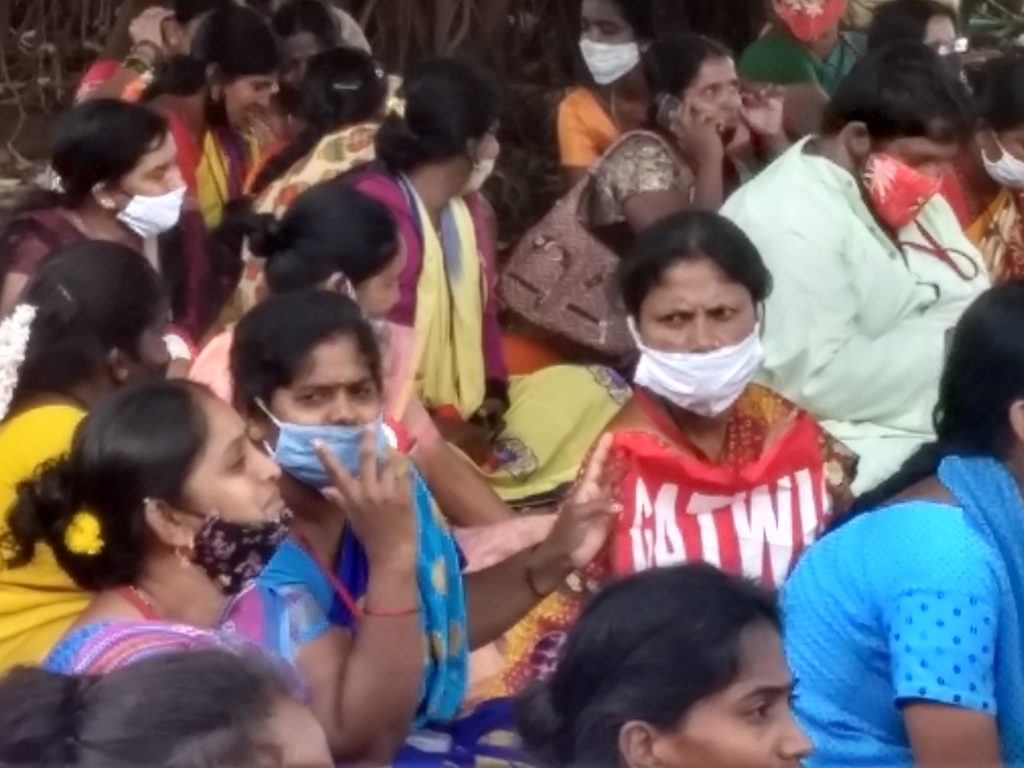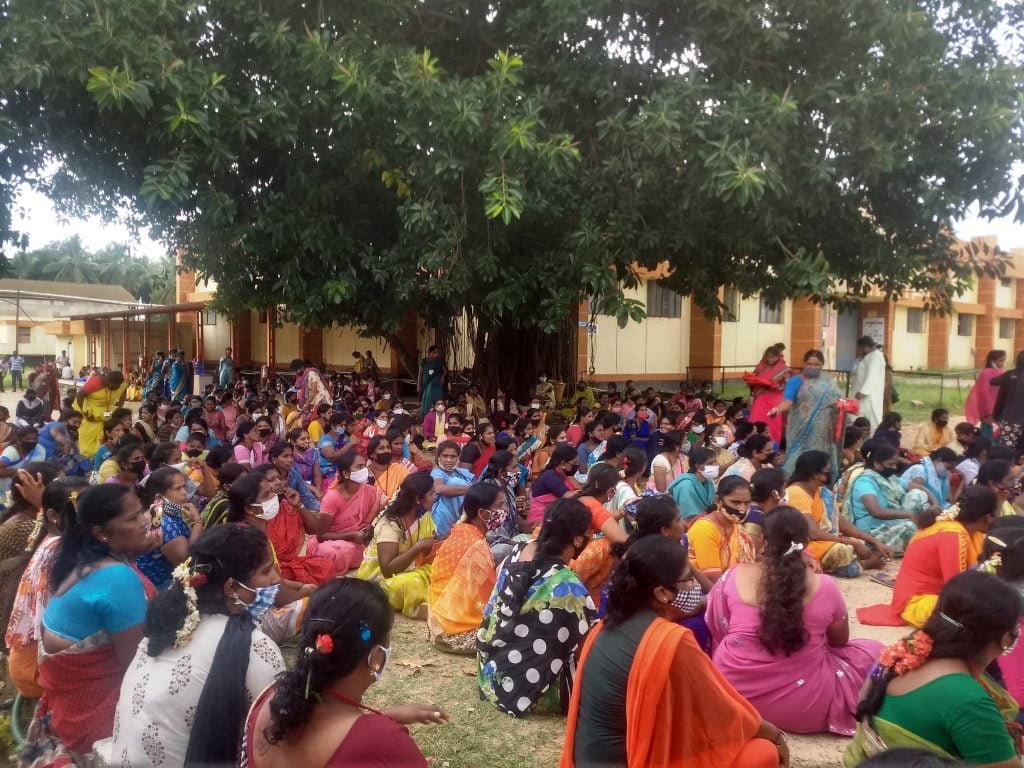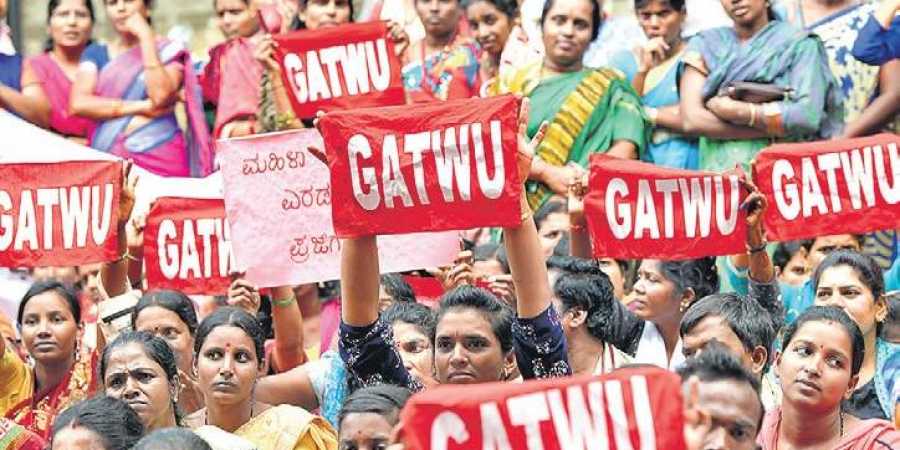Editor’s Note: This month, that is January 2021, FII’s #MoodOfTheMonth is Work and The Workplace, where we invite various articles to highlight the profound changes that our workplaces may or may not have undergone and the effect that these changes have had on our personal and professional lives and ways of living in the time of the pandemic. If you’d like to share your article, email us at pragya@feminisminindia.com.
Posted by Swathi Shivanand
For ten years since 2010, Pavithra had worked in the cutting section of the Euro Clothing Company-2 (ECC-2), a unit of Gokaldas Exports, in Srirangapatna. But on June 6, 2020, life as she had known came to a grinding halt. Her factory announced a sudden, and illegal layoff, putting her and over 1300 workers in the factory out of work. Gokaldas Exports claimed that the transnational apparel corporation Hennes and Mauritz, better known as H&M, had reduced its orders due to the COVID-19 pandemic. It had no choice but to close down the factory, it claimed.

The closure of the factory left many feeling that the ground beneath their feet had been snatched away. “It feels like someone has blindfolded us and left us in the jungle. There is no light anywhere for us. (This factory) was like a ray of light for us but we feel like we are being pushed back into darkness,” said Pavithra, in her interview with us.
Stunned but angry at the illegal layoff, Pavithra and other women workers in the factory sat down in protest at the factory premises. For over 50 days, led by their union—the Garment and Textile Workers’ Union (GATWU)—workers in the factory protested against the arbitrary actions of both Gokaldas and H&M. Their only demand: Open our factory.
There were several remarkable aspects to this protest:
Hundreds of women workers, from villages in a largely-rural district, protested for 50 days.
Against a reputed garment manufacturer and an international clothing brand.
During a world-wide pandemic.
In the garment industry.
“In the history of organising in the garment industry, it’s hard to sustain workers for this long,” R. Prathibha, president of GATWU had explained to us in an interview. Several factors make it difficult to sustain protests, not least is the fact that the factory management brings a great deal of pressure to resign.
Stunned but angry at the illegal layoff, Pavithra and other women workers in the factory sat down in protest at the factory premises. For over 50 days, led by their union—the Garment and Textile Workers’ Union (GATWU)—workers in the factory protested against the arbitrary actions of both Gokaldas and H&M. Their only demand: Open our factory.
Illegal Pressure Tactics by Gokaldas Exports
From the moment it announced its layoff at ECC-2 factory, Gokaldas Exports went about coercing resignations from workers. Supervisors were reportedly paid Rs. 400 for each resignation they managed to elicit. These men fanned out to villages of workers in their departments, put pressure on them and their spouses, sometimes as late as 12 in the night, and managed to get resignations. One such pressure point that supervisors deployed with women workers was the patriarchal control families exert on them.
As Prathibha explained to us, supervisors know familial and personal details about workers’ lives, know exactly what a worker’s pressure points are (financial distress, overbearing husband) and use them cleverly against workers to get them to resign. In some cases, Pavithra told us, supervisors reportedly taunted husbands or sons of the women for ‘letting their women’ be out in public and protest. Another worker told us that some women workers who resisted these pressures were cowed into submission by their husbands who beat them into resigning.
The company reportedly even went to the extent of getting auto-drivers who ferried women between their villages and the factory to apply pressure on women to resign. Even village elders were reportedly used as another pressure point to get women to resign. “If some women in a village had refused to resign and were joining in the protest at the factory, they were subject to taunts by those in the village. “See, she thinks she can get the factory to open. Look at her go”—such kinds of comments were directed at the women,” Prathibha said.
Over time, many resigned. But till the end of 50 days, nearly 600 workers resisted these pressures from family and factory management and protested against the illegal and arbitrary layoff.
What explains this resistance by women workers of the ECC-2 factory?
‘Aase’, ‘Commitment’, Desperation
Before Pavithra joined the ECC-2 factory, her mother and she used to roll agarbathis (incense sticks). For twelve hours of continuous, back-breaking work, both used to earn a combined total of Rs.150-Rs.200 per day. In comparison, the Rs.8000 or so Pavithra started to earn at the factory was a much better deal. Her ‘desires’ soared, just a little, and she began to send her only son to a private, convent school. The fees were high and had to be paid 3-4 times a year, along with an annual ‘donation’ of Rs. 20,000.
Also read: Why Women Workers Are Protesting Against H&M
For atleast three generations, Pavithra’s family had been without assets such as land and house and had survived on the strength of their labour. She had not had much education herself after she lost her father at an early age and her struggling mother married her off early. Sending her only son to a ‘good school’ had been a great desire, something she couldn’t do when she depended on her husband who rarely provided for the family. “We come work here in the factory, we feel like we should take our kids upto some level. Aase. They (the company) are burying this aase too. Should only their children go on to become doctor, engineers? Should our children remain at this level only?” Pavithra asked.
In some cases, Pavithra told us, supervisors reportedly taunted husbands or sons of the women for ‘letting their women’ be out in public and protest. Another worker told us that some women workers who resisted these pressures were cowed into submission by their husbands who beat them into resigning.
As we spoke to the protesting workers, the Kannada term ‘aase’ came up repeatedly, one that translates into something akin to a mix of desire, hope and longing. The aase that these women referred to—a ‘good’ education for their children, a house of their own, and some funds to invest into farming—may have seemed well within their reach when they were earning regular salaries. “There was a certain courage that I will manage things somehow. I get a salary. I can work. With the company around, we felt like there is someone to support us,” Pavithra said.
The paltry wages provided to women workers in a factory don’t amount to much by itself. It’s the steadiness of wages—i.e. the certainty of a monthly wage—that provided women the confidence to undertake ‘commitments’, a term used often to refer to debts. Most loans were borrowed from ‘kendras’, the village-level entity of the big business of rural microfinance. These loans had enabled women to make modest, incremental changes to their life and over time, their ‘commitments’, i.e. debts, had grown. Loan repayments had to be made every week to the kendra. Women feared that they would be humiliated, their integrity and respectability questioned, if they failed to repay. This was their main cause of worry when the factory announced the layoff.
Mandya’s Economy: No place for Women
The desperation women workers felt at the sudden layoff announced at their factory prompted one of the longest protests in the garment industry in India in recent times. Part of that desperation was the knowledge that there was simply no work for women in Mandya’s economy. The verdant greenery of the irrigated district of Mandya hides many sorts of inequities, and gender discrimination is built into the structure of the economy. A primarily agricultural district, women working in farms earned around Rs.50 a day (The Human Development Index report of 2014 for the district however stated that women agricultural labourers earned between Rs.100 and Rs.145). These low and seasonal wages did not offer any avenues for financial autonomy for women.
State neglect of the region has also meant that the region has little to no industries where women can be employed. Service sector employment within the district is largely non-existent for women. It was only when a few garment manufacturing companies started their units in the district, women like Pavithra and Poornima had no way to stand on their feet. Working women may have become acceptable, albeit grudgingly, in villages. But women were still expected to not travel ‘too far’ and work only in places to which transport is cheap and easily available.
Migration, or even daily travel to the cities of Bangalore or Mysore are impossible for women bound by structures of patriarchy in the village and the family. Employment at ECC-2 factory met these patriarchal criteria of nearness and ease of access for women workers of the factory. Over time, the factory grew to be a lifeline for them and their families.
Strength of the Union
Workers may have been desperate for the factory to reopen. But their ability to sustain the protest was primarily due to the strength and mobilisational efforts of GATWU. Worker-leaders took the industrial dispute of the layoff both to the state government and international dispute resolution forums. They argued that the layoff was illegal because Gokaldas Exports had not sought mandatory permission from the state government. With H&M, GATWU demanded that the apparel brand stand up to its voluntary commitments to protecting workers’ rights to organise and collectivise.

But the most challenging part of the struggle was to help workers resist familial, societal and factory management’s pressures. As sit-in protests became difficult due to increase in COVID-19 cases in the city, worker-leaders started WhatsApp groups to provide updates on the negotiations conducted by the union, share images of the shows of support from across the world to workers at ECC-2 factory and to provide moral support to the workers. They even confronted management personnel who were travelling to villages to coerce workers into resigning and shared videos of these confrontations with workers.
Also read: Migrant Women Workers On The Road: Largely Invisible And Already Forgotten
The End of Sit-in Protests
At the end of 50 days, most workers resigned when the company offered them enhanced compensation packages. These packages were nearly two to four times higher than what their colleagues who resigned during the protests had got. Although the factory remains closed, the enhanced compensation packages are a sign of what an organised workforce can bargain for itself in the face of arbitrary and illegal actions of an intransigent management.
This episode at Srirangapatna is an extraordinary exception in the history of the garment industry in the global south. Its exceptionality raises questions about the future of work for the feminised workforce of a highly exploitative garment industry.
Are women workers meant to silently suffer silently the systemic capitalist patriarchy of the industry?
What avenues out of this can we as a society imagine for women workers?
(This article is based on the report ‘Laid off during the pandemic: A case study of the closure of a garment factory’, produced by the Alternative Law Forum)
Swathi is a research consultant at ALF. She has a doctorate in Modern History from JNU and her interests are in areas of urban, region, labour and gender. You can find her on Twitter and Facebook.
Featured Image Source: New Indian Express




